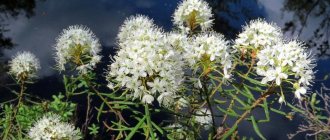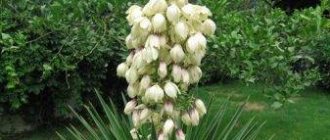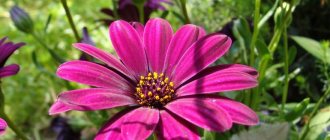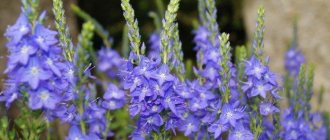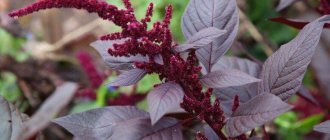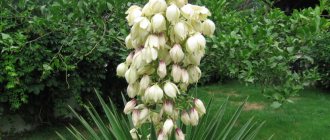general information
Oregano, hemlock, oregano - all these and many other similar names actually refer to the same heather shrub. Ledum is distributed throughout almost the entire Northern Hemisphere.
Ledum honey plant is widely used in folk medicine, and the beneficial substances in its composition are recognized even by official medicine. But remember that all its parts are poisonous, and the pungent aroma can cause weakness and dizziness.
The height of the bush ranges from 50 to 120 cm, depending on the species. Ledum has a superficial, but powerful and branched rhizome with equally powerful and branched stems. They are strong, but thin, and can be straight or creeping.
Over time, the shoots of wild rosemary become woody, but the young stems are covered only with reddish pubescence. Dense, dark and elongated leaves exude that same scent of dope. In spring, last year's wild rosemary shoots are covered with white or pink umbrella inflorescences.
Photo: yesofcorsa.com
Black crowberry
An evergreen branched, creeping shrub with dark brown leaves from the crow family. The leaves are small, elliptical. The flowers are axillary, pink, appear in May-June. The fruit is a black berry. It grows in peat bogs, in damp places in the tundra and polar-arctic zones of the Polar, Subpolar and Northern Urals.
Crowberry has long been known as a sedative. Therefore, an infusion of the herb (a tablespoon of herb in a glass of boiling water) is used for fatigue, headaches, nervous functional disorders, and also against scurvy. In Tibetan medicine, crowberry is used to treat kidney disease and anthrax. In Transbaikalia, an infusion of the herb is used in the treatment of epilepsy and paralysis. Nenets, Khanty and Mansi tie crowberry branches, soaked for half an hour in warm water, to wounds and abrasions for faster healing.
Types of wild rosemary
The wild rosemary genus is not so diverse and rich. There are only a few main varieties of it, and even fewer in Russia. Let's talk about them!
Large-leaved wild rosemary
The eastern guest prefers rocky and mountainous terrain. It grows in Japan, Korea and, of course, the Far East. This is a compact variety that grows on average to 50-60 cm, although sometimes taller specimens are found. The leaves of this wild rosemary are really large for its genus - up to 4 cm.
Photo: happy-nokia.ru
Marsh wild rosemary
This is a resident of regions with a temperate climate. It is branched, quite spreading and tall - up to 120 cm in height. The bush grows actively and blooms at the end of spring. The aroma of marsh wild rosemary is slightly less pungent.
Photo: mrfilin.com
Transbaikal wild rosemary
A distant relative of the rhododendron has brighter and more decorative flowering. Its pink flowers can even be seen in bouquets. The bush itself is very tall and branched, and in some cases reaches up to 2 m.
Photo: multiurok.ru
Greenland wild rosemary
The most frost-resistant species that is not afraid of any cold weather at all. It has very tough, medium-sized shoots up to 90 cm, which lie towards the ground as they grow. The stems are densely and densely covered with needle-like fleecy leaves. Umbrella inflorescences of small cream flowers reach up to 6 cm in diameter.
Photo: lesjardinsdemalorie.be
Lilies of the valley (50 photos): types, planting and proper care
Blueberry
A shrub from the heather family, 80-100 cm high, with gray smooth curved branches. The leaves are obovate, bluish below. The flowers are pink, spherical-bell-shaped. The fruit is a juicy berry, bluish-black, with a bluish bloom. Ripens in July-August. You need to pick the berries carefully, as they are very delicate. Dry in a shaded place with good ventilation. Blueberries grow in damp places, in moss swamps, and in the moss-lichen tundra of the Ural Mountains.
Leaves and berries are a good antiscorbutic remedy and are used in the treatment of diabetes and constipation. A decoction of the branches helps with heart pain; the berries are used in the treatment of giardiasis angiocholecystitis.
Caring for wild rosemary
Considering the conditions in which wild rosemary lives in nature, it does not need any special care. Moreover, the plant has excellent immunity and even repels pests on its own.
Temperature and lighting
Ledum is not afraid of frost and winters well in open ground. Occasionally, in a snowless winter, young shoots may suffer, but they can simply be thinned out in the spring. The plant is indifferent to the sun, partial shade or even strong shading.
Photo: agronom-world.ru
Watering
Ledum prefers damp areas and ponds, so in any other place regular and intensive watering is required. It can only be reduced during prolonged rainfall.
Photo: ericaceae.org
The soil
The soil should be loose and quite acidic. You can add sphagnum or just pine needles. Periodically loosen the soil and remove weeds, but remember that the root system of wild rosemary is very close to the surface.
Photo: klkfavorit.ru
Fertilizers and fertilizing
Several times a season, wild rosemary can be fed with mineral fertilizers. But this is not necessary and is rather relevant for the blooming Transbaikal species.
Photo: web-zoopark.ru
Planting and propagation
In nature, wild rosemary reproduces by seeds from small capsules, which themselves crack as they ripen. An adult plant can be propagated by layering. To do this, you need to dig a flexible branch into the soil, leaving the top free, and just wait for rooting.
Large bushes can be cut into sections and then immediately planted in new places. And summer healthy semi-lignified cuttings take root well in loose, nutritious soil, but this takes a long time, and they will only be able to be transplanted outside next spring.
The optimal depth of the planting hole is 40-60 cm, and good drainage is required. The distance between the bushes should be at least 60-70 cm. After planting, it is recommended to mulch the top with peat.
Photo: fototerra.ru
Loosestrife (50 photos): types, planting and care in open ground
Sweet clover
Biennial herbaceous plant from the legume family, with a branched stem up to 1 m in height. The leaves are small, complexly trifoliate, with serrate-toothed edges and subulate-shaped stipules, arranged alternately. The small yellow flowers are very fragrant, collected in elongated racemes. It grows in fields, meadows, along roads, on slopes, ravines, and fallow lands of the Southern Urals.
The herb used for medicinal purposes is the tops of shoots with leaves and flowers. Collect during flowering. Infusion and decoction of sweet clover has an expectorant, emollient, carminative, and analgesic effect. In scientific medicine, sweet clover herb is used to prepare an extractable green patch and is included in emollient mixtures that accelerate the opening of abscesses and boils. Herbal infusions are prescribed for chronic bronchitis, insomnia, migraines, ailments caused by high blood pressure and menopause, thrombophlebitis, and liver diseases.
Using wild rosemary in the garden
Ledum is not very decorative, but it is sometimes planted in wet, swampy areas where other plants do not take root. In addition, he feels good near bodies of water. It can also be planted in the shade between tall trees and on rocky areas. And also - use as a hedge when zoning.
Photo: zen.yandex.ru
Castor bean (50 photos): types, care and planting in open ground
Contraindications, overdose
Given the characteristics of wild rosemary, you should be careful with this plant. An overdose of the plant can cause poisoning, irritation, depression of the central nervous system, and inflammation of the gastric mucosa.
The esters contained in the plant can cause paralysis of the limbs. With a moderate overdose, poisoning occurs, and a severe overdose leads to paralysis.
An overdose can lead to paralysis of the lower and upper limbs and the heart muscle. Preparations from wild rosemary are contraindicated for hepatitis, pancreatitis, glomerulonephritis. They should not be taken during pregnancy and for children under 16 years of age, as well as in case of individual intolerance to the plant.
To avoid negative consequences, it is recommended to consult a specialist before taking wild rosemary.
Ledum – photo
Keep an even larger selection of photos to make it easier for you to identify wild rosemary and finally decide what you think about it!
Photo: nat-geo.ru
Photo: oir.mobi
Photo: drive2.ru
Photo: flo.discus-club.ru
Photo: mrfilin.com
Photo: poleznii-site.ru
Photo: uborka-v-dome.ru
Photo: plantarium.ru
Photo: fotoload.ru
Photo: domsvechei.ru
Photo: zhenskiye-sovety.ru
Photo: kustroz.ru
Photo: flo.discus-club.ru
Photo: nat-geo.ru
Photo: flower.onego.ru
Photo: na-dache.pro
Photo: svb28.ru
Photo: les.media
Photo: zen.yandex.ru
Photo: zen.yandex.by
Photo: zen.yandex.ru
Photo: blotos.ru
Photo: viplor.ru
Photo: distano.ru
Did you like the post? Subscribe to our channel in Yandex.Zen, it really helps us in our development!
